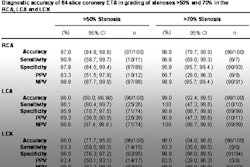A new phantom study concludes that institutional MDCT protocols, when used in pregnant women, yield radiation doses well below levels thought to induce neurologic harm to the developing fetus, although the risk of its eventually developing cancer later in life may still be elevated for certain exams that expose the fetus directly.
The authors, Dr. Lynne Hurtwitz and colleagues from Duke University in Durham, NC, noted that the American College of Radiology (ACR) recommends the use of nonionizing imaging modalities such as ultrasound and MRI as the first choice in pregnant women.
"However, CT is often used for such indications as suspected pulmonary embolus, appendicitis, renal colic, or trauma, including pregnancy in some situations," they wrote in the American Journal of Roentgenology. "The use of CT in this setting likely stems from its familiarity and wide availability, and from the fact that sonography is often limited in pregnant women" (AJR, March 2006, Vol. 186, pp. 871-876).
Fetal radiation doses have been measured for axial and single-slice CT scanners, the researchers stated, adding that doses from 16-slice scanners have probably not been previously reported. The study sought to measure the radiation doses from 16-slice MDCT of the chest, abdomen, and pelvis during early pregnancy.
The study used an anthropomorphic phantom (model 702 CIRS) modified to model the body of a pregnant woman and expected location of the fetus in early pregnancy. The phantom was made of a material with the same x-ray interaction as human tissue. "Landmarks for uterine location and shape at 0 and 3 months' gestation were determined on the basis of MIRD (medical internal radiation dosimetry) mathematic phantom series for the pregnant woman," the authors wrote.
The researchers placed thermoluminescence detectors (TLDs) and metal-oxide semiconductor field-effect transistor (MOSFET) detectors in appropriate locations to determine radiation exposure to the fetus at 0 and 3 months' gestation "because this is the time of greatest radiosensitivity for the developing fetus," they wrote.
Images were acquired on a 16-slice CT scanner (LightSpeed, GE Healthcare, Chalfont St. Giles, U.K.) using the group's current institutional protocols for common applications:
- Renal stone (140 kVp, 160 mAs, rotation 0.5 sec, 16 x 0.625 mm)
- Appendix (140 kVp, 340 mAs, rotation time 0.5 sec, 16 x 0.625 mm)
- Pulmonary embolus (140 kVp, 380 mAs, rotation time 0.8 sec, 16 x 1.25 mm)
The results showed the following radiation doses to the fetus at 0 and 3 months, respectively:
- Renal stone protocol: 0.8-1.2 and 0.4-0.7 cGy
- Appendix protocol: 1.52-1.68 and 2-4 cGy
- Pulmonary embolus protocol: 0.024-0.047 and 0.061-0.066 cGy
"The dose to the fetus in the first trimester for chest pulmonary embolus protocol is low, in agreement with other investigations," the authors wrote. "The fetal dose is close to that of a V/Q scan at the beginning of the first trimester, and approximately double that of the V/Q scan at the change from the first to the second trimester."
There is no direct radiation, only scattered radiation, in PE exams, they noted. And while their dose results for this exam were low, other investigations have done better, with doses ranging from 3.3-20.2 µGy in the first trimester and up to 76.7 µGy in the second trimester, likely due to protocol differences including thicker collimation in another study.
The doses are higher, logically, for renal stone and appendix imaging protocols that result in direct fetal exposure, they noted.
"Our institution uses a full abdominal and pelvic protocol for appendix imaging because differentiating appendicitis from other abdominal and pelvic disorders can be difficult during pregnancy," they wrote.
The major risks to the fetus are neurologic and carcinogenic in nature, Hurwitz et al wrote. But according to International Commission on Radiological Protection (ICRP) atomic bomb survivor data on pregnant women who were exposed in Japan, doses 10 cGy and higher would be the minimum expected to produce significant neurologic impairment in the fetus.
The correlation between fetal radiation exposure and later cancer is less well-established, but an estimate based on the linear no-threshold model suggests that the highest protocols in the present study could theoretically double the chance of developing childhood cancer.
Using this model, the relative risk of developing childhood cancer from dose levels used in diagnostic radiology exams has been estimated at 2.7 for early gestational age fetuses.
"In addition, the excess relative risk (ERR) of developing childhood cancer for a fetus incurring 3.0 cGy of radiation exposure from appendix MDCT protocols is approximately 2 in 600, as opposed to 1 in 600 for the control general population in developed nations," the group wrote.
Strategies such as lowering the tube current, limiting z-axis coverage, increasing pitch, and reducing gantry cycle time can yield significant further dose reductions, the authors noted.
By Eric Barnes
AuntMinnie.com staff writer
March 27, 2006
Related Reading
BEIR VII and separating fact from fear, November 18, 2005
Study shows radiation causes cancer but rarely, June 30, 2005
Cancer risk linked to radiation exposure – study, June 29, 2005
Studies cast doubt on low-level radiation dangers, January 30, 2003
Even moderate doses of radiation may cause nervous system tumors, October 16, 2002
Copyright © 2006 AuntMinnie.com




















